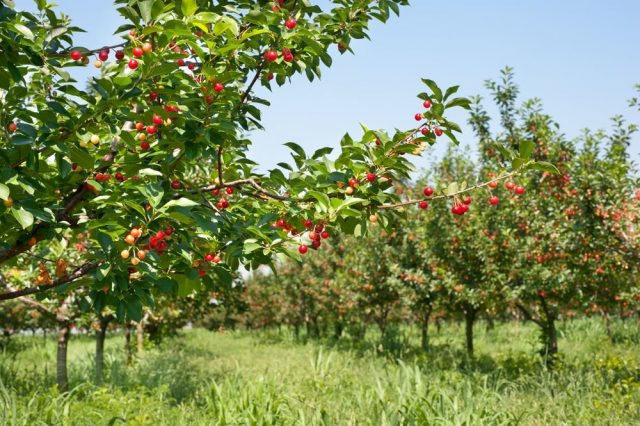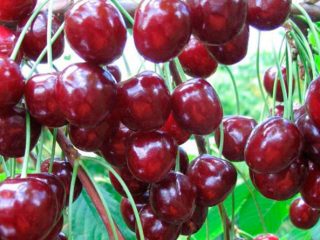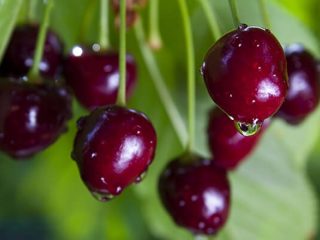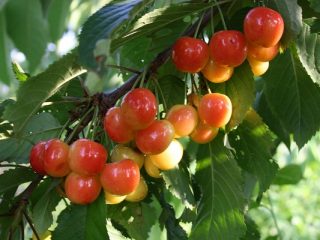Content
Among the young cherry varieties popular among a narrow circle of gardeners, one stands out. The Memory Astakhov cherry, bred quite recently, is of considerable interest to lovers of fruit trees - so it is interesting to understand its features.
History of variety selection
This variety is of Russian origin: its originator is the All-Russian Research Institute of Lupine, and the famous breeder M.V. Kanshina took direct part in the breeding. The variety was named after her husband, also a famous breeder. An entry about the new variety was entered into the State Register quite recently - in 2014.
Description of the cherry variety In Memory of Astakhov
Externally, the cherry tree is a medium-height tree no more than 4 m with dark gray flaky bark on the main trunk.The spreading crown of slightly rounded outlines is formed by the shoots: the lower ones, gray-brown, are located horizontally, and the brown upper ones are inclined towards the main trunk. The density of the crown is average, flat green leaves with teeth along the edges are held on medium-sized petioles. Cherry blossoms early, producing small white flowers - 3 on each inflorescence.
As for the fruits, these cherries are usually light, pink in color, weighing about 5–8 g. Covered with a thin but dense skin, the berries are easily separated from the stalk. The taste of the fruit is pleasant - Astakhovka has earned a high tasting score: 4.8 points out of a maximum of 5.
An important feature of the cherry tree is that its seedlings take root well in almost any climatic conditions. The variety was bred in Bryansk and was originally intended for the middle zone of the Central region. However, it is grown even in the Urals: its very high frost resistance contributes to the popularity of Astakhov’s Memory among amateur gardeners.
Characteristics of the variety
The cherry tree, named after Astakhov, was developed only a few years ago. Therefore, many gardeners know a minimum of information about it. And before purchasing seedlings for your plot, you would like to get acquainted with the characteristics in detail.
Drought resistance, frost resistance
Among the unique qualities that make this variety popular are two features: the tree’s high resistance to low temperatures and arid climates.
- The variety's tolerance to lack of moisture is assessed as average. However, in reality, a tree can survive completely without watering for a month. We are talking not only about artificial, but also about natural hydration.Drought does not affect the yield properties of cherries.
- Even more surprising is the frost resistance of the Memory of Astakhov. The buds of the fruit tree can withstand temperatures down to -32 degrees - for cherries this is a very high indicator. This is precisely the reason for the widespread distribution of the variety beyond the Urals: in cold winter conditions, hardy fruit trees are worth their weight in gold.
Cherry pollinators In memory of Astakhov
Unfortunately, this variety is self-sterile: on its own it is not capable of producing rich harvests. In order for the maximum number of berries to appear on the branches, pollinating varieties are required that are planted in close proximity.
For the Memory of Astakhov, these varieties are:
- Cherry Revna — the variety blooms in the 3rd decade of May, and the fruits appear on the branches by the end of July.
- Cherry Ovstuzhenka - a variety with medium flowering periods and early fruiting: berries appear on its branches in early June.
- Cherry Iput — the fruit tree blooms in May, and the first berries appear on the branches in early summer, in June.
All of the listed varieties, like Pamyat Astakhov, were bred at the All-Russian Research Institute of Lupine and are similar in flowering time. That is why they are ideal for pollinating the Memory of Astakhov - gardeners with extensive practical experience advise planting several different pollinators in the immediate vicinity of the variety to increase productivity.
Productivity and fruiting
Memory of Astakhov bears its first fruits 5 years after planting on the site.Productivity is defined as average and largely depends on specific climatic conditions and care. Under favorable circumstances, one cherry can produce up to 80 kg of berries, but in practice, about 50–70 kg of fruits are more often collected from Astakhov’s Memory.
Area of application of berries
The tasty and tender berries of the Memory of Astakhov are usually consumed fresh, since early varieties of cherries are stored for a very short time. Until the berries begin to deteriorate, they can be used to prepare desserts and baked goods, to create juices, fruit drinks and compotes.
Resistance to diseases and pests
Diseases affect Astakhov's Memory cherries quite rarely. The variety also has good immunity to pests. However, sometimes fungal diseases, such as gray rot and tinder fungus, still affect the health of the tree.
In this case, it is necessary to promptly remove the diseased parts of the plant and carry out treatment with special preparations: antifungal agents or a classic solution of copper sulfate.
Advantages and disadvantages of the variety
The variety has both pros and cons. The undoubted advantages include:
- highest resistance to low temperatures down to -32 degrees;
- good tolerance to dry weather;
- high level of productivity and pleasant taste of fruits;
- strong immunity to diseases and insect pests.
The main disadvantage of the variety is its self-sterility. Along with the Pamyati Astakhov cherries, you will definitely have to plant related varieties with similar flowering periods, otherwise you may not expect a good harvest.
Landing Features
Planting Memory of Astakhov differs little from planting other types of cherries, but you need to know some features and rules.
Recommended timing
Theoretically, the variety can be planted in both spring and autumn. But, since young seedlings are still sensitive to low temperatures, experienced gardeners prefer spring planting.
Choosing a suitable location
It is best to place seedlings in a well-lit place, on the south side. Particular attention should be paid to the soil: cherries do not take root well on deep sandstones and wet clay. The ideal soil would be loam or sandy loam.
What crops can and cannot be planted nearby?
- It is recommended to plant pollinating varieties or cherries in close proximity.
- You can also place rowan or grapes nearby.
- But apple trees, plums and pears do not get along with cherries at close range.
Selection and preparation of planting material
It is recommended to use seedlings of the second or third year of growth. Before purchasing, you must make sure that the roots of the tree are well developed and not damaged, and that there are a small number of buds on the branches.
Landing algorithm
The hole for the cherry seedling must be dug a month before the actual planting.
- The bottom of the recess is filled in advance with a mixture of humus and ordinary soil, about 400 g of superphosphate and 1 kg of ash are added, and mixed.
- The seedling is placed in a hole, the roots are sprinkled with soil so that the root collar remains above the surface.
- The tree is watered with 10–20 liters of water, having previously formed an earthen “roller” around the trunk, and the soil is mulched.
Aftercare for cherries
There is almost no need to trim growing cherries - only shrunken and diseased branches are removed. In addition, every year after harvesting, it is customary to prune the fruit-bearing branches by a third.
Watering is carried out depending on the weather: with average precipitation, 20–40 liters of water under the trunk will be enough. During the growing season, it is recommended to increase the frequency of watering to 2 times a month, and during severe drought - to once a week.
In subsequent years, in the spring, the tree can be fed with nitrogen fertilizers, a little potassium substances can be added to the soil in the summer, and fluorine-containing substances can be added in the fall.
Preparation for winter is carried out as follows:
- In mid-September, the soil within a radius of a meter from the trunk is loosened, watered properly and humus or peat is scattered in a layer of 10–15 cm.
- At the end of September, it is useful to add superphosphate to the soil, and before the onset of winter, whitewash the trunk with lime.
- To protect against frost and rodents for the winter, the lower part of the trunk can be wrapped with roofing felt. After snow falls, you can throw a snowdrift around the trunk and trample the snow around the cherry tree.
Diseases and pests, methods of control and prevention
Sometimes Astakhov's Memory suffers from gray mold or tinder fungus. They deal with them this way: damaged parts of the tree are removed, and healthy parts are treated with special solutions.
Good help
- Fitosporin;
- copper sulfate solution.
Conclusion
Sweet cherry Pamyati Astakhov is a fruit variety ideal for growing in the middle zone and the Urals. Sweet cherries tolerate harsh climates well and continue to delight with delicious fruits.
Reviews of cherries in memory of Astakhov


















